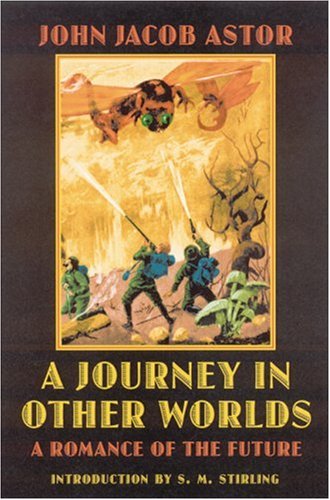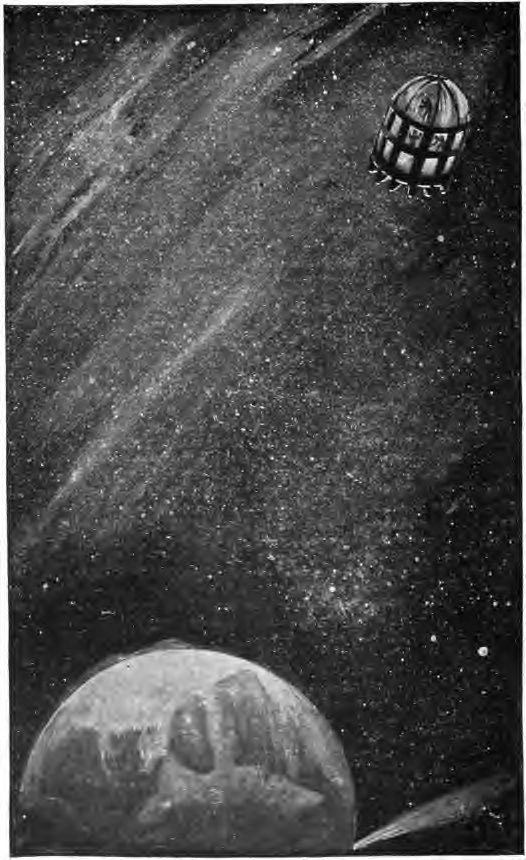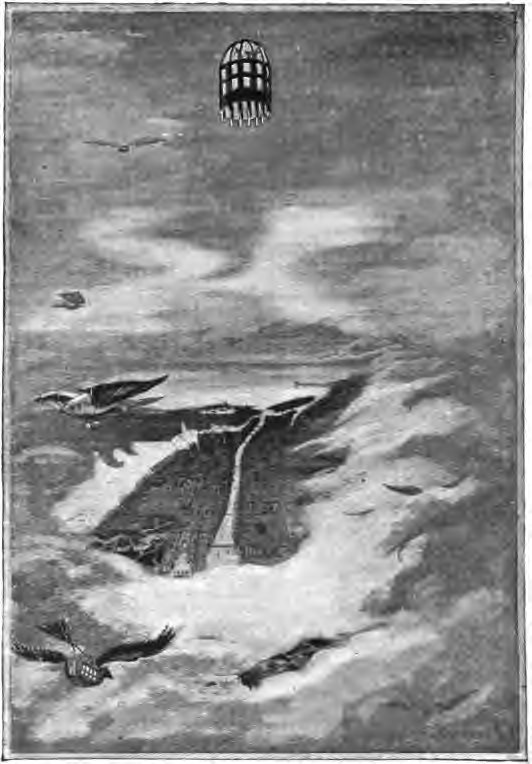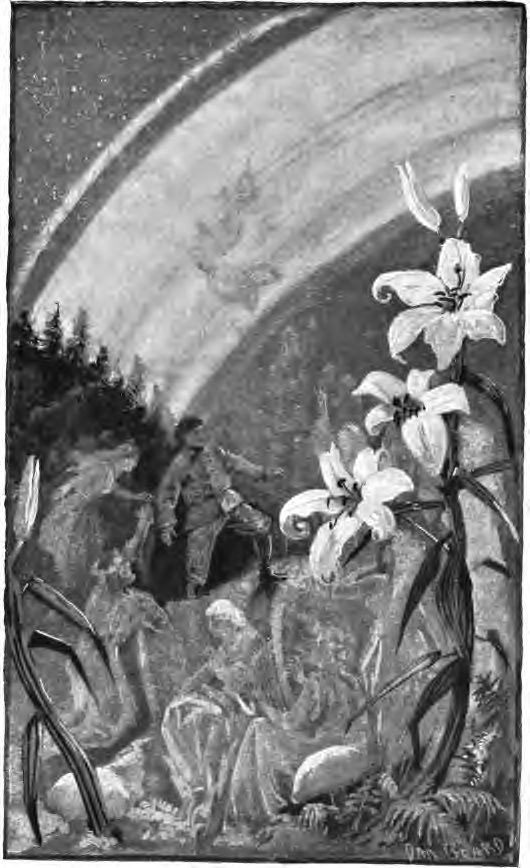The exploration of old and relatively unknown science fiction can be rewarding on many levels. In addition to seeing the author’s vision of the future, one also gets a snapshot of the accepted science of the time, usually riddled with surprising misconceptions. When the author himself is famous for reasons other than writing, the book has in a sense hit the “trifecta of interesting”.
Such is the case with A Journey in Other Worlds, published in 1894:
The author of the book is John Jacob Astor IV (1864-1912), American millionaire and inventor, builder of what eventually became the Waldorf-Astoria Hotel in New York — and one of the wealthiest victims of the 1912 sinking of the RMS Titanic .
The book is a science fiction adventure, following the exploits of a handful of intrepid explorers as they take the first interplanetary voyage, visiting Jupiter and Saturn. The tale is set in the far future, but also amusingly filled with 19th century mores and views.
(Images from original edition of book, via Project Gutenberg.)
The story starts with a bang:
Jupiter — the magnificent planet with a diameter of 86,500 miles, having 119 times the surface and 1,300 times the volume of the earth — lay beneath them.
They had often seen it in the terrestrial sky, emitting its strong, steady ray, and had thought of that far-away planet, about which till recently so little had been known, and a burning desire had possessed them to go to it and explore its mysteries. Now, thanks to APERGY, the force whose existence the ancients suspected, but of which they knew so little, all things were possible.
Ayrault manipulated the silk-covered glass handles, and the Callisto moved on slowly in comparison with its recent speed, and all remained glued to their telescopes as they peered through the rushing clouds, now forming and now dissolving before their eyes. What transports of delight, what ecstatic bliss, was theirs! Men had discovered and mastered the secret of apergy, and now, “little lower than the angels,” they could soar through space, leaving even planets and comets behind.
Three men have come to Jupiter in the spaceship Callisto. The first, Colonel Bearwarden, is the President of the Terrestrial Axis Straightening Company — more on this in a moment! The second, Professor Cortland, is an aging and brilliant scientist who consulted for Bearwarden. The third, Dick Ayrault, is a wealthy shareholder in the company and friend of the first two. The trio, riding the wave of the success of their company, have endeavored to take on the exploration of the solar system as a new challenge.
The signals from the Arctic Circle.
The secret of their spacecraft is “apergy”, what would be known in modern science fiction as “anti-gravity”. The ability to nullify, reverse, or enhance gravity makes it possible to push and pull a craft through the solar system at astonishing speeds.
They arrive on a Jupiter teeming with life, some familiar and some not so familiar. The Professor hypothesizes that the planet is passing through its own Carboniferous or Devonian period of history, with species similar to those that thrived on earth yet super-sized in accordance with the planet size.
What follows is a “lost world” style adventure, with the explorers venturing out into the mysterious wilds, encountering animal, vegetable and mineral wonders. It is a dangerous world, and the men have to rely on their guns more than once to get out of hairy situations. After traveling from the equator to the poles of Jupiter, they set off to explore Saturn — and are met with an experience that will challenge and transform their understanding of God, religion, and the nature of the universe.
The combat with the dragons.
Though it is superficially written as a science fiction adventure, A Journey in Other Worlds is at heart a statement of John Jacob Astor’s philosophical views on science, technology and faith. Each of these aspects is worth exploring a little bit.
As can be seen from even the very first sentences of the novel, quoted above, Astor practically revels in his scientific knowledge. At practically every opportunity, he throws scientific facts at the reader: astronomy, physics, biology, and paleontology are all included. Mid-way through the book, there’s even a table listing the characteristics of the various planets! (Pluto is not included in the list, as it was not discovered until 1930.)
Though he is clearly well-read and has a familiarity with diverse scientific fields, there are a number of examples where Astor’s lack of expertise shines through. For instance, consider the explorers’ first attempt to venture outside of their craft:
Finding a firm strip of land between the forest and an arm of the sea, they gently grounded the Callisto, and not being altogether sure how the atmosphere of their new abode would suit terrestrial lungs, or what its pressure to the square inch might be, they cautiously opened a port-hole a crack, retaining their hold upon it with its screw. Instantly there was a rush and a whistling sound as of escaping steam, while in a few moments their barometer stood at thirty-six inches, whereupon they closed the opening.
Emphasis mine! Not knowing the pressure outside the spacecraft, they cracked open the door to find out. If you know anything about pressurized chambers and explosive decompression, you know that this would be a very bad idea! A particularly graphic example of this is the 1983 Byford Dolphin accident, in which a deep-sea decompression chamber burst, going from 9 atmospheres of pressure to 1 atmosphere in an instant, leading to the grisly deaths of 5 people. Though the dangers of decompression may not have been obvious to people of Astor’s era, the oversight stood out quite shockingly to me when I read it.
Other times, Astor gets the science of his era correct but that science is now known to be wrong; it is quite fascinating to see this “snapshot” of late 19th-century ideas. For example, there is the off-hand observation about volcanic activity contained in this passage:
By sunset they had gone a hundred miles. Wishing to push along, they closed the windows, rose higher to avoid any mountain-tops that might be invisible in the moonlight, and increased their speed. The air made a gentle humming sound as they shot through it, and towards morning they saw several bright points of light in which they recognized, by the aid of their glasses, sheets of flame and torrents of molten glowing lava, bursting at intervals or pouring steadily from several volcanoes. From this they concluded they were again near an ocean, since volcanoes need the presence of a large body of water to provide steam for their eruptions.
Emphasis again mine. Though water can increase the explosive capability of an eruption, volcanoes do not need water to power eruptions. It seems that Astor was reciting the prevailing (and incorrect) theory of his time.
Though he was very interested in cutting edge scientific theory, Astor did not shy away from flights of science fiction fancy; some of his ideas are quite clever and even beautiful. For instance, the first sunset on Jupiter reveals some surprises in the fauna:
Although the sun was still far above the horizon, the rapidity with which it was descending showed that the short night of less than five hours would soon be upon them; and though short it might be very dark, for they were in the tropics, and the sun, going down perpendicularly, must also pass completely around the globe, instead of, as in northern latitudes on earth in summer, approaching the horizon obliquely, and not going far below it. A slight and diffused sound here seemed to rise from the ground all about them, for which they could not account. Presently it became louder, and as the sun touched the horizon, it poured forth in prolonged strains. The large trumpet-shaped lilies, reeds, and heliotropes seemed fairly to throb as they raised their anthem to the sky and the setting sun, while the air grew dark with clouds of birds that gradually alighted on the ground, until, as the chorus grew fainter and gradually ceased, they flew back to their nests. The three companions had stood astonished while this act was played. The doctor then spoke:
“This is the most marvellous development of Nature I have seen, for its wonderful divergence from, and yet analogy to, what takes place on earth. You know our flowers offer honey, as it were, as bait to insects, that in eating or collecting it they may catch the pollen on their legs and so carry it to other flowers, perhaps of the opposite sex. Here flowers evidently appeal to the sense of hearing instead of taste, and make use of birds, of which there are enormous numbers, instead of winged insects, of which I have seen none, one being perhaps the natural result of the other. The flowers have become singers by long practice, or else, those that were most musical having had the best chance to reproduce, we have a neat illustration of the ‘survival of the fittest.’ The sound is doubtless produced by a shrinking of the fibres as the sun withdraws its heat, in which case we may expect another song at sunrise, when the same result will be effected by their expanding.”
(Emphasis again mine.) I find the idea of flowers that attract by sound rather than scent to be intriguing.
Astor does more than speculate on science in his novel, however; he also lays out a utopian vision of the year 2000 that includes dramatic technological change. Remarkably, he accurately envisions a number of technologies that have become very important today. For instance, consider the following modification to ships:
The hollow masts of our ships–to glance at another phase en passant–carry windmills instead of sails, through which the wind performs the work, of storing a great part of the energy required to run them at sea, while they are discharging or loading cargo in port; and it can, of course, work to better advantage while they are stationary than when they are running before it.
Astor’s ships are hybrid vehicles — much of the energy used to run the ships comes from storing wind power while at port! Also, consider:
Steam-boilers are also placed at the foci of huge concave mirrors, often a hundred feet in diameter, the required heat being supplied by the sun, without smoke, instead of by bulky and dirty coal. This discovery gave commercial value to Sahara and other tropical deserts, which are now desirable for mill-sites and for generating power, on account of the directness with which they receive the sun’s rays and their freedom from clouds. Mile after mile Africa has been won for the uses of civilization, till great stretches that were considered impassible are as productive as gardens.
Here we have a crude imagining of the implementation of solar power on a massive scale!
The Callisto was going straight up. (Note the bird-like flying machines!)
Astor is perhaps a bit too optimistic about future technology: another cringe-inducing activity in his utopian society is the aforementioned “Terrestrial Axis Straightening Company”, whose goal is to remove the tilt in the earth’s axis and therefore remove the existence of seasons altogether. With the threat of global climate change hanging over us today, the idea of deliberately modifying the climate is quite horrifying. In Astor’s time, however, there was little appreciation of the devastating effect such changes would have on the global ecosystem.
On a social and political level, Astor has much less to say. Wars are finally abolished due to the development of powerful weapons and the threat of mutually assured destruction (as we have noted previously, H.G. Wells would envision a similar result a few years later). The U.S. government remains unchanged, maintaining the same executive, legislative, and judicial branches. The only significant political change is the entry of Canada and Mexico into the Union! Though it is not described in much detail, the existence of the TASC suggests that Astor envisions corporations playing a much greater role in managing society. This is not surprising, considering his upper-class background!
Astor’s characters are clearly reflections of Astor himself, and have a “high society” approach to life and exploration. The entire expedition seems to be less a scientific investigation than an entertaining outing for wealthy vacationers. When they encounter completely strange and mysterious new species, their first instinct is: “Let’s shoot it!” One suspects that Astor based his adventure on safaris that he may have personally taken part in.
Though his characters are high society, there isn’t much else to them — it is quite clear that Astor was less concerned with plot and characterization than with presenting his ideas. The only one who has any back story worth mentioning is Dick Ayrault, who must leave his beloved fiancée behind to embark on the mission. She plays a moderately significant role in the “plot”, especially when the explorers move on to Saturn.
For me, the arrival on Saturn is when the story “jumps the shark”. The explorers encounter disembodied spirits, who reveal secrets of nature and the afterlife. This section is apparently a reflection of Astor’s own theological views, but has the unfortunate effect of muddling the otherwise entertaining science fiction tale. I kind of tuned out at this point: once powerful spirits are protecting our explorers, the tension in the story is pretty much eliminated.
Ayrault’s vision.
In spite of its limitations, however, the story is a charming one, and the 19th century speculations on science and technology alone are well worth reading. Just be warned that you won’t be getting a story without many twists and turns, or character development!
The tragic death of such a famous figure as Astor on the Titanic spawned many legends about him, most of which are certainly fiction. It is known that he asked to board a lifeboat with his wife, who was in a “delicate condition” (i.e. pregnant), but was refused. After that, he is credited with one certain act of kindness, as recounted by survivor Louis Garrett, who was 12 years old at the time of the sinking:
What a sight! Most of the lifeboats were gone. The crew was permitting women and children only to board the lifeboats-there were not enough for everyone. We saw women crying, not wanting to leave their husbands; husbands begging their wives and children to hurry and get into the lifeboats. Amid this complete pandemonium and mass hysteria stood my sister and I, two immigrant children, unable to speak English, frightened beyond belief, crying and looking for help.
The last lifeboat was being loaded. A middle-aged gentleman was with his very young, pregnant wife. He helped her into the lifeboat, then looked back to the deck and saw others wanting to get aboard. He kissed his wife good-bye, and, returning to the deck, grabbed the first person in his path. Fortunately, I was there in the right place at the right time and he put me into the lifeboat. I screamed for my sister who had frozen from fright. With the help of others, she also was pushed into the lifeboat. Who was the gallant man who performed this kind act? We were told he was John Jacob Astor IV. At that time he was 45 years old and his wife, Madeleine, was 19. They were traveling to the United States because they wanted their child to be born there. Many newspaper stories were written that told how John Jacob Astor gave up his life for a young immigrant. The Astor family records indicate that, according to Mrs. Astor, Mr. Astor had words with a crewman who tried to prevent him from helping his wife into the lifeboat. He did so anyway. And, as I said, he kissed her and, returning to the deck, began helping others into the lifeboat.
Astor is now remembered best as being a victim of the Titanic, but he should also be credited with a fascinating early work of science fiction.








“Apergy” figures in the Warren Ellis comic book/graphic novella Aetheric Mechanics, which you might enjoy.
Hmm… I’ll have to look into it! 🙂
Does he give any indication of what removing the Earth’s axial tilt is supposed to achieve?
Yes – the goal is to remove the extreme seasonal climate variations and consequently make much more of the world inhabitable. Folks of Astor’s time didn’t appreciate the potential devastation from such a major change to a delicate ecosystem!